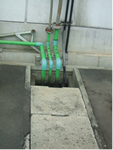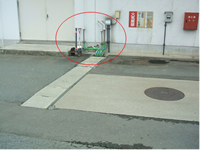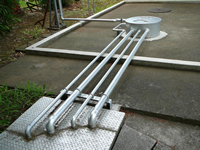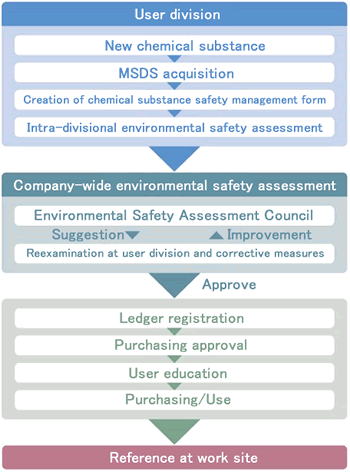Environmental Report 2011
Reducing Environmental Risks
Prevention of Soil and Groundwater Pollution
The discovery of soil and groundwater contaminated with hazardous substances is on the rise in Japan due to the redevelopment of former plant sites and voluntary surveys. Since countermeasures after contamination has already occurred take a vast amount of time and money, this is gaining recognition every year as a massive social problem. Amid these developments, Japan's Water Pollution Control Law was amended in 1989 and 1996 in an effort to strengthen measures against groundwater pollution, and in 2002, efforts to rework related regulations began, including the promulgation of the Soil Contamination Countermeasures Law.However, according to the "Ideal State of Measures for Effectively Preventing Ground Water Pollution," a report by the Central Environment Council that was compiled in February 2011, actions resulting in groundwater pollution were confirmed to be continuing even after 1989, when it was widely thought they had been brought under control. Thus, further pollution-prevention measures are required of firms that handle hazardous substances and facilities that cause pollution.
The JAE Group has been preventing contamination by such means as double-walling underground storage facilities and pipes, but in FY 2010, it went even further by launching efforts to assess the risks of leaks and seepage into the soil at facilities that handle hazardous substances and those that handle fuel oil. Assessment results showed there was a large risk at some older facilities that were in place before work on revising the related laws commenced. The Group is making repairs and other remedial efforts, with such facilities as the top priority.


(double walling) (YAE)

Chemical Substance Management/PRTR Information
To manage the risks associated with chemical substances, JAE makes suitable appointments of legally designated managers and qualified personnel with consideration given to their division and age.Continuing from the previous fiscal year, the environmental management plan included efforts to reduce use of chemical substances, and further efforts were made to reduce their environmental impact.
Chemical Substance Management
The introduction of a new chemical substance or piece of equipment, construction work, increased waste volume, and other changes require an environmental safety assessment under JAE's in-house pre-assessment system. For chemical substances, it has prepared an ad hoc chemical substance safety management form for the entry of requisite information on items including transport, storage, handling, and disposal. New chemical substances in particular can only be purchased if they pass this assessment. The pre-assessment flow for new chemical substances is shown below.The following table presents data for chemical substance registration in FY 2010. JAE inspects and registers many chemicals for R&D and process improvement. In conjunction with this, it also reviews the use of many chemicals that are no longer needed, but with the total number in FY2010, the company has been aggressively trying to implement further cuts in the number that are no longer needed.
■JAE Akishima Plant
| 2008 | 2009 | 2010 | |
|---|---|---|---|
| Number registered | 2,217 | 2,249 | 2,183 |
| Discontinued | 48 | 52 | 172 |
| New | 172 | 84 | 107 |
| Number of distinct chemical substances registered | 1,733 | 1,753 | 1,782 |
■Pre-assessment flowchart for new chemical substances

Reduction of Chemical Substances
In FY 2010, target substances were selected per production site to reduce environmental impact. The goal is to reduce use of these substances by 10%. The main examples of activities for reducing chemical substances in FY 2010 are as follows.- Reducing usage of two kinds of solvents by improving cleaning methods (SAE)Efforts to reduce the amount of solvents used for cleaning resulted in a halving of the previous amount for some solvents. This was part of a reduction study from among chemical substances with a long history of usage that excluded substances for which changes in the amount used in production processes to ensure product performance would be difficult. Moving forward, the JAE Group will work to protect the environment by promoting reductions in the amount of volatile organic compounds used.
- Reducing the usage of two kinds of solvents by reusing washing fluids and improving processes (JAE)
JAE is making the following efforts with the objective of reducing the amount of two kinds of solvents used by 10% of the previous fiscal year level. Both kinds of solvents have been classified as volatile organic compounds (VOCs) based on Japan's Air Pollution Control Law.- Replacing some solvents with those not subject to a regulatory system
- Reusing cleaning fluids
- Adding a pre-wiping process before cleaning (shortens cleaning time, controls fouling, and promotes reuse)
- Switch to small, closed cleaning vessels according to part size (controls amount used and evaporation), etc.
PRTR Data
Japan's revised PRTR Law was promulgated in 2008. This changed the kinds of chemical substances that are targeted by the law, and starting on April 1, 2010, the JAE Group began identifying the newly targeted substances it was using. The amount of methylnaphthalene contained in bunker A (fuel oil) used in boilers and n-Propyl bromide contained in cleaning fluid for metal parts exceeded one ton, which meant they were subject to PRTR reporting. Reports were filed by electronic and other means.The following table shows the change in substances subject to reporting and the amount of such substances used that were subject to RoHS directives. These figures are the combined value of five domestic manufacturing companies, and the ★ marks correspond to the number of production sites that were subject to PRTR reporting. Antimony and its compounds were used in the material for forming connectors (antimony trioxide) due to their fire resistance, but starting in FY 2009, the JAE Group began reducing antimony and its compounds by switching to other materials. The Group had also been reducing hexavalent chromium and lead, which are substances subject to RoHS directives, for several years. Reductions have leveled out over the past several years, but this is due to the Group's response to the demands of customers for uses that are not subject to RoHS. Since reducing waste is also crucial in dealing with PRTR-targeted chemical substances, the Group is promoting recycling and working to identify trends.
■Change in Volume of PRTR-Designated Chemical Substances Used Unit: tons
| Fiscal | 2007 | 2008 | 2009 | 2010 |
|---|---|---|---|---|
| Antimony and its compounds | ★★11.2 | ★★19.9 | ★★4.9 | ★2.4 |
| Inorganic cyanide compounds | ★2.7 | ★2.1 | ★1.8 | ★2.8 |
| Hexavalent chromium compounds | 0.16 | 0.14 | 0.15 | 0.18 |
| Nickel | ★7.7 | ★5.8 | ★6.0 | ★6.4 |
| Nickel compounds | ★2.7 | ★1.9 | ★2.5 | ★2.9 |
| Hydrogen fluoride and its water-soluble salts | ★★5.2 | ★★4.6 | ★3.4 | ★★4.5 |
| Lead and its compounds | 0.21 | 0.30 | 0.10 | 0.16 |
| n-Propyl bromide | - | - | - | ★★★8.9 |
| Methylnaphthalene | - | - | - | ★★★★8.6 |